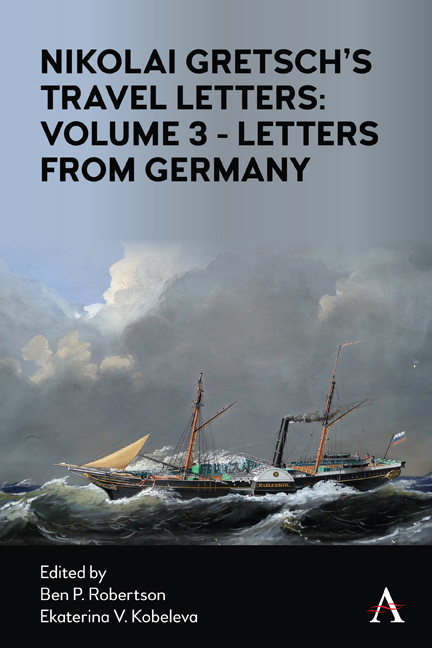Book contents
- Frontmatter
- Contents
- List of Illustrations
- Abbreviations
- Miscellaneous Frontmatter
- Introduction to Volume 3
- Letter XXXI
- Letter XXXII
- Letter XXXIII
- Letter XXXIV
- Letter XXXV
- Letter XXXVI
- Letter XXXVII
- Letter XXXVIII
- Letter XXXIX
- Letter XL
- Letter XLI
- Notes on this Translation
- Selected Bibliography
- Index
Letter XXXIII
Published online by Cambridge University Press: 22 October 2021
- Frontmatter
- Contents
- List of Illustrations
- Abbreviations
- Miscellaneous Frontmatter
- Introduction to Volume 3
- Letter XXXI
- Letter XXXII
- Letter XXXIII
- Letter XXXIV
- Letter XXXV
- Letter XXXVI
- Letter XXXVII
- Letter XXXVIII
- Letter XXXIX
- Letter XL
- Letter XLI
- Notes on this Translation
- Selected Bibliography
- Index
Summary
The location of Munich. A view of the city. Hotels. Survey of the history of Bavaria. The districts of Munich. The Glyptothek. Antiquities. Frescoes. The fall of Troy.
The environs of Munich are not attractive: the city lies on an elevated plain (1624 Par. feet above sea level) bound on the south by the Tyrol Alps, which shield it from the southern winds and thus cause considerably harsh temperatures. The soil is sandy, barren. Forests and groves are very rare. The Isar and other rivers that we crossed flow quickly down the slope to the north, and in the summer, they overflow from the melting snow at their sources. As we approached closer to the city, the royal summer residence of Schleissheim appeared in the distance to the right, and on the left—small country cottages separated from the road by wide meadows. A large park was visible behind them. At the entrance to the city from this side, there is neither any gate, nor guard post, nor bascule barrier: The houses of a wide street (Ludwigßtrase) begin abruptly along both sides of the road immediately at the end of the open fields—two rows of big, magnificent buildings, in part finished, in part under construction, some merely foundations and others being decorated inside. The first building on the right side is a university: a huge structure, already finished in the rough. Next is an institute for girls and a school for the blind; on the left side is the Church of St. Ludwig, with the house of the archbishop and a seminary; farther on is a public library and other large-scale buildings constructed with delicate taste. The whole town is clean, neat, respectable looking. There are fairly many people in the streets, but no beggars. The sidewalks are not made of slabs, but are paved with small stones, laid out in beautiful patterns. Soon, the street split into two: the left ran past the old royal palace; the right, past the magnificent Theatiner Kirche to the post house. On the advice and with the help of a friendly travel companion, Mr. Fickenscher (son of a famous manufacturer from Wunsiedel), I took a room in the oldest hotel in Munich—of the Black Eagle on Kaufingerstraße.
- Type
- Chapter
- Information
- Publisher: Anthem PressPrint publication year: 2021

